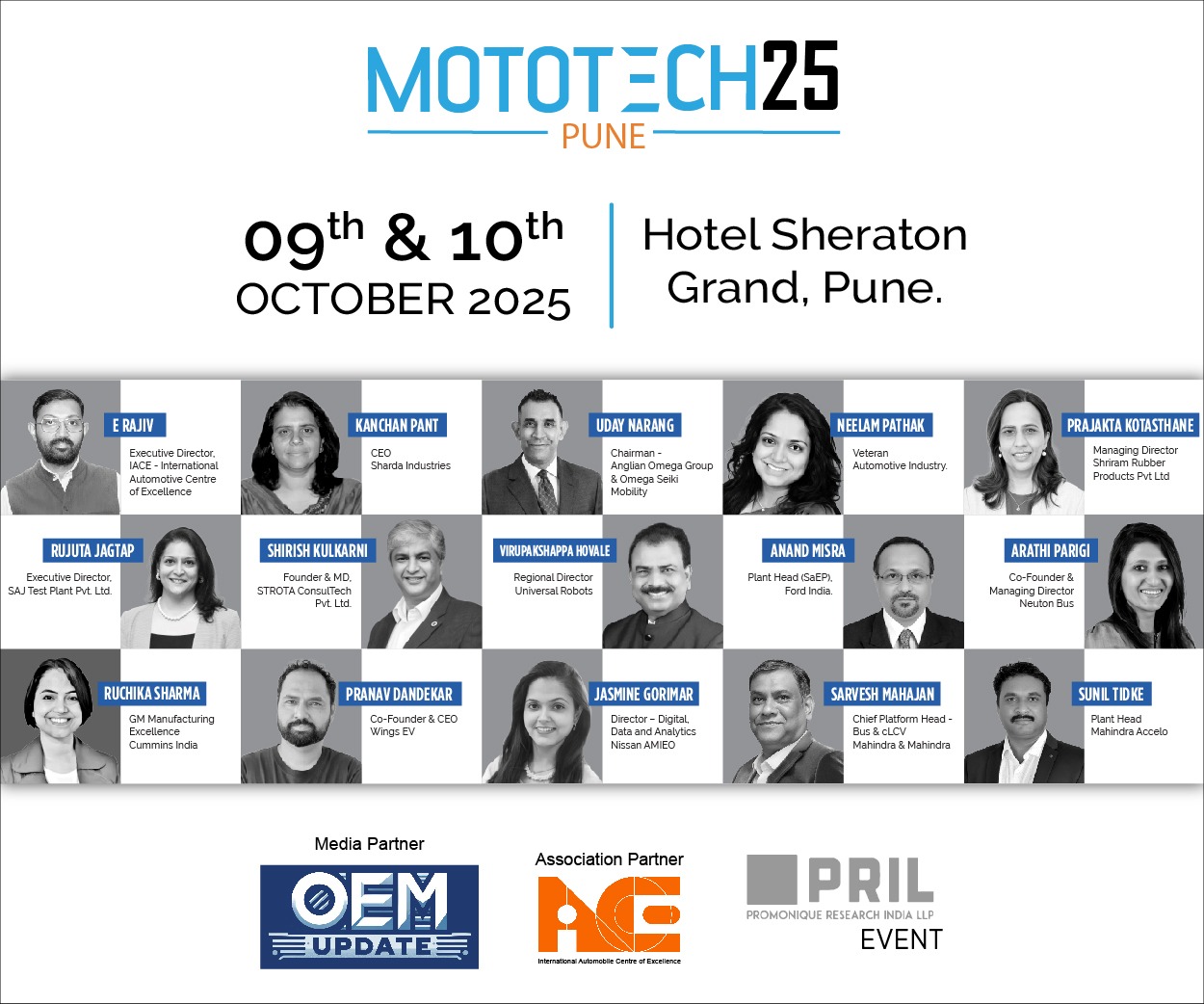All that is new with semiconductors!
By Staff Report September 6, 2025 4:09 pm IST
A lot is happening in the manufacturing, and in vogue are semiconductors. India is rapidly advancing its semiconductor sector due to the bold government vision and massive investment. The nation is moving from a chip design powerhouse to a full-stack manufacturing hub.
Semiconductors have become the latest to nab big investments. They enable crucial systems in healthcare, transportation, communication, defence, and space. With increased digitisation and automation worldwide, semiconductors are now critical for economic security and strategic independence. In a mere four years since its creation in 2021, the India Semiconductor Mission (ISM) has evolved the Indian semiconductor journey from a dream into reality. To back the vision, a PLI scheme of ₹76,000 crores has been put forth, with around ₹65,000 crores already committed.
To establish India as a major hub for semiconductor design and manufacturing, SEMICON India was inaugurated by Prime Minister Narendra Modi on September 2 in New Delhi. With nearly 350 exhibiting companies from 33 countries and regions and a record number of stakeholders outside of India, this fourth edition was the largest ever held in India. SEMICON India 2025 was jointly organised by the India Semiconductor Mission (ISM) under the Ministry of Electronics and Information Technology (MeitY) and SEMI, the global semiconductor industry association. Another major landmark in India’s semiconductor journey was witnessed on August 28, with the launch of one of the country’s earliest-ever comprehensive Outsourced Semiconductor Assembly and Test (OSAT) Pilot Line Facilities at Sanand, Gujarat. Semiconductor company CG-Semi is supposed to manufacture the first ‘Made in India’ chip through this pilot facility.
Through the Design Linked Incentive (DLI) scheme, 23 chip design projects have been sanctioned to support startups and innovators. Companies like Vervesemi Microelectronics are creating advanced chips for defence, aerospace, electric vehicles, and energy systems, showing that India is no longer just a consumer but a creator.
The Strategic Fulcrum
Prime Minister Narendra Modi’s declaration that semiconductors are the “digital diamonds” of the 21st century frames India’s strategic push in a global context. This draws a direct parallel to the geopolitical significance of oil in the last century and putting the immense economic and strategic power on a tiny chip. The government’s explicit vision is to transform India from a mere consumer of chips into a “full-stack semiconductor nation,” signifying the development of a comprehensive ecosystem that encompasses every step of the value chain: from design and intellectual property (IP) creation to manufacturing (fabs), packaging (OSAT/ATMP), and final product integration. This ambition is a direct and calculated response to the global supply chain fragilities that were exposed by recent geopolitical and health crises, which brought automotive production to a standstill worldwide.
The major focus behind all these efforts is to bring up India’s role as a “lighthouse of stability and growth” in a period of global policy turmoil. This message is to attract global players looking to diversify away from concentrated manufacturing hubs like Taiwan and China. This is supported by a significant increase in the semiconductor budget allocation in 2025 by 83%, to ₹7,000 crores.
The provided data reveals that India is not simply expanding its semiconductor efforts; it is undergoing a fundamental strategic pivot. For decades, India has cultivated a globally recognised strength in chip design, accounting for approximately 20% of the world’s integrated circuit (IC) design workforce. Global technology giants like Qualcomm, Intel, Nvidia, Broadcom, and MediaTek have established large R&D and design centres across Bengaluru, Hyderabad, and Noida, strengthening India’s role in the global chip ecosystem. While this has made India a crucial player in the design phase, the country has remained strategically vulnerable due to its utter lack of indigenous manufacturing. The announcements at Semicon India 2025 demonstrate a decisive move beyond this single-pillar strength. The new focus on fabrication and outsourced assembly and test (OSAT) facilities, segments where India has historically been absent, represents a pragmatic shift. By actively building these capital-intensive capabilities, India is leveraging its design talent as a foundational asset to attract investment in the next logical segments of the value chain, thereby building a more resilient and self-reliant ecosystem.
Indigenous Innovation
A major highlight of Semicon India 2025 was the unveiling of the Vikram-32 microprocessor, which Union Minister Ashwini Vaishnaw presented to the Prime Minister. Developed by the Indian Space Research Organisation’s (ISRO) Semiconductor Laboratory (SCL), it is India’s first fully indigenous microprocessor, specifically designed to withstand the extreme environmental conditions of space launch vehicles. This development marks a significant milestone in India’s efforts to reduce dependency on imported chips. The chip was validated in space on the PSLV Orbital Experimental Module (POEM-4) during the PSLV-C60 mission, a crucial step in proving its readiness for future missions.
The Vikram-32 is developed on SCL’s 180nm CMOS technology, operates at a clock speed of 100 MHz, and can function across a wide temperature range from −55°C to 125°C.
The National Institute of Technology (NIT), Rourkela, and the Parala Maharaj Engineering College (PMEC), Berhampur, jointly developed three chips that were also showcased at the conference. These include a lightweight encryption core for IoT applications, a sensor circuit for biomedical systems and energy harvesting, and a high-performance multiplier for facial recognition, demonstrating a decentralised, innovation-led approach to solving domestic technological needs.
The public unveiling of chips like the Vikram-32 and the NIT/PMEC designs is a powerful act of strategic communication.
Investments on the Ground
The government has approved 10 semiconductor projects with a cumulative investment of over ₹1.6 lakh crore (approximately $19.5 billion), with nearly ₹65,000 crore of the ₹76,000 crore Production Linked Incentive (PLI) scheme already committed. This financial commitment is translating into tangible progress.
Construction has commenced on India’s first AI-enabled semiconductor fabrication plant in Dholera, Gujarat, a project led by Tata Electronics in collaboration with Taiwan’s Powerchip Semiconductor Manufacturing Corporation (PSMC). The ₹91,000 crore project, which aims to produce 50,000 wafers per month, will focus on mature technology nodes from 28nm to 110nm. This strategic decision is designed to cater to high-demand sectors like automotive, AI, and data storage, which require these specific technologies.
Parallel to the fab investments, significant progress is being made in the assembly, test, and packaging (OSAT/ATMP) segment. Micron’s $2.75 billion ATMP facility in Sanand, Gujarat, is reportedly 60% complete, with the first phase expected to become operational by late 2025 or early 2026. The pilot line of CG Semi, in collaboration with global partners Renesas and Stars Microelectronics, was also inaugurated. With an investment of over ₹7,600 crore, the G1 facility will begin commercial production in the calendar year 2026, with a peak capacity of around 0.5 million units per day. The G2 facility, under construction, will scale production to 14.5 million units per day upon completion in late 2026.
India has a calculated strategy with this. Rather than directly competing in the sub-10nm race with global leaders like TSMC, the country is focusing on mature nodes that are the workhorses of the global economy, powering cars, industrial automation, and IoT devices. This focus ensures that India addresses a large and growing domestic market, projected to exceed $120 billion by 2030, thereby guaranteeing demand for its output. Simultaneously, the aggressive push into OSAT/ATMP facilities is a crucial strategic step. These are less capital-intensive than full-scale fabs but are essential for creating a complete value chain.
| Company (Lead) | Partner(s) | Location | Investment (₹ Cr / $ Bn) | Project Type | Status/Capacity |
| Tata Electronics | PSMC (Taiwan) | Dholera, Gujarat | ₹91,000 Cr / ~$11 Bn | Fabrication (Fab) | Construction started; 50k wafers/month; 28-110nm |
| Tata Semiconductor | NA | Morigaon, Assam | ₹27,000 Cr / ~$3.3 Bn | OSAT/ATMP | Approved |
| Micron Technology | NA | Sanand, Gujarat | ₹22,516 Cr / ~$2.75 Bn | OSAT/ATMP | 60% construction complete; production in late 2025 |
| CG Power | Renesas, Stars Microelectronics | Sanand, Gujarat | ₹7,600 Cr / ~$0.87 Bn | OSAT/ATMP | Pilot line launched; commercial production in 2026 |
| Kaynes Semicon | NA | Mohali, Punjab | ₹3,307 Cr | OSAT/ATMP | Approved |
| HCL-Foxconn JV | NA | Jewar, Uttar Pradesh | ₹3,700 Cr | OSAT/ATMP | Approved |
| SicSem | Clas-SiC Wafer Fab (UK) | Bhubaneswar, Odisha | ₹2,066 Cr | Compound Semiconductor | Approved |
| 3D Glass Solutions Inc. | NA | Bhubaneswar, Odisha | ₹1,943 Cr | Advanced Packaging | Approved |
| ASIP | NA | Andhra Pradesh | ₹468 Cr | Advanced Packaging | Approved |
| CDIL | NA | Mohali, Punjab | ₹117 Cr | Assembly/Testing | Approved |
Global & Domestic Partnerships
The Semicon India 2025 conference served as a nexus for a series of significant collaborations and announcements, totalling 13 major developments that mark another leap forward in India’s semiconductor journey. One of the most significant announcements was the formation of the India Deep-Tech Investment Alliance (IDTA), a coalition that has committed to invest $1 billion to mobilise private capital and expertise for deep-tech startups across various sectors, including semiconductors. This is a critical next step from government-led incentives.
These new collaborations are designed to fill specific gaps in the ecosystem and strengthen the value chain. For instance, Tata Electronics and Merck signed an MoU under which Merck will support Tata’s Dholera fab with materials, infrastructure, and supply chain solutions, highlighting the need to localise upstream components. In a bid for greater indigenous innovation, Kaynes Semicon announced multiple collaborations with domestic startups (SPARSH-IQ, 3rdiTech, Focally, and SenseSemi Technologies) and a global partner (Infineon) to develop indigenous automotive AI vision solutions and MEMS microphones. Furthermore, L&T Semicon, in a partnership with IIT Gandhinagar and C-DAC, is developing a “Make-in-India Secure Chip” with a Smart Operating System designed for next-gen digital identity products like e-passports.
The formation of IDTA is a key indicator of the evolution of India’s semiconductor strategy. The initial phase of the India Semiconductor Mission (ISM) was primarily driven by substantial government financial support through the PLI and Design Linked Incentive (DLI) schemes. These incentives were crucial for de-risking the massive capital investments required for fabs and OSATs. The announcement of the IDTA signifies a transition to a more sustainable model, where the government’s initial commitment has built sufficient confidence to now attract significant private capital and expertise. This shift demonstrates that the ecosystem is maturing beyond state support and is starting to be powered by market forces. It is a powerful signal to the global investment community that India is a viable, long-term destination for deep-tech investment.
Building the Talent Pipeline
While India boasts a strong foundation in chip design, hosting approximately 20% of the world’s chip design engineers, the sector is facing a severe skill gap, particularly in manufacturing. A recent study estimated a shortage of 250,000-300,000 semiconductor professionals by 2027. To address this, significant new initiatives have been announced to build a robust talent pipeline.
A new collaboration between Ramaiah University of Applied Sciences (RUAS) in Bangalore and the University at Albany (UAlbany) now allows Indian students to enrol in graduate certificate programs in semiconductor manufacturing, patterning, processing, and metrology, providing access to advanced, specialised training from a global leader. Simultaneously, the ISM has signed an MoU with the New Age Makers Institute of Technology (NAMTECH) to develop a future-ready talent pipeline through specialised programs in semiconductor manufacturing, automation, and AI. These programs offer industry placement pathways. In another instance of international collaboration, NIELIT signed an MoU with the Singapore Semiconductor Industry Association (SSIA) to boost semiconductor skilling and industry-academia linkages.
This proactive approach is specifically tailored to address a known vulnerability in India’s semiconductor ambition. The talent pool, while large, is heavily skewed towards chip design. The manufacturing and packaging side of the business requires a different set of hands-on, technical skills that are currently in short supply. The new programs are building a new, indigenous pipeline of skilled workers from the ground up, ranging from diploma-level technicians to post-graduate engineers, to meet the needs of the emerging fabs and OSATs. This systematic effort demonstrates that the government and industry are not just focused on attracting the initial investments but are also building the long-term, sustainable human capital foundation required to operate and scale these complex facilities.
To foster talent development in semiconductor chip design, the Government has rolled out several initiatives, which include:
- AICTE Curriculum: A new curriculum introduced by the All India Council for Technical Education (AICTE) for VLSI Design & Technology and Integrated Circuit (IC) manufacturing.
- Skill Development: Plans to develop 85,000 skilled professionals in the semiconductor design sector and provide EDA (Electronic Design Automation) tools to design semiconductor chips over the next 10 years.
- Student Enrollment: More than 45,000 students from 100 institutions have already enrolled.
- SMART Lab at NIELIT Calicut: The Skilled Manpower Advanced Research and Training Lab aims to train 1 lakh engineers nationwide, with over 44,000 engineers trained so far.
- Industry-University Collaboration: Partnerships with leading institutions and companies like Lam Research, IBM, and Purdue University.
- C2S Program: By August 2025, 278 academic institutions and 72 start-ups will have received access to EDA tools.
- Beneficiaries: Around 60,000 students have benefited as of August 2025.
- Chip Fabrication: 20 chips have been fabricated by 17 institutions so far (as of August 2025).
- Future Skills Program: A government initiative in Madhya Pradesh to train 20,000 engineers.
- Micron–IIT Roorkee MoU: A partnership signed to drive innovation and develop a highly skilled workforce.
By leveraging India’s vast talent pool, global semiconductor design companies are increasingly expanding their workforce in India to design cutting-edge chips.
| Partners | Project / MoU Name | Objective & Significance |
| Tata Electronics & Merck | MoU | To support Tata’s Dholera fab with materials and supply chain solutions, crucial for a localized ecosystem. |
| Tata Electronics & C-DAC | MoU | To strengthen India’s design and IP ecosystem, providing support for startups and MSMEs. |
| Kaynes Semicon & Consortium | Indigenous Automotive AI | To support Tata’s Dholera fab with materials and supply chain solutions, crucial for a localised ecosystem. |
| L&T Semicon & IISc Bangalore | National Innovation Hub | To build India’s first hub for semiconductor and quantum tech research, combining academia and industrial expertise. |
| L&T Semicon & IIT Gandhinagar/C-DAC | Make-in-India Secure Chip | To develop a secure chip for digital identity solutions like e-passports, a strategic application. |
| ISM & NAMTECH | MoU | To build a future-ready talent pipeline by designing specialized programs for semiconductor manufacturing. |
| ISM & Arizona State University | MoU | To build a future-ready talent pipeline by designing specialised programs for semiconductor manufacturing. |
Challenges
A nuanced understanding of India’s semiconductor journey requires acknowledging a history of missed opportunities. From the 1960s through the early 2000s, India repeatedly failed to capitalise on interest from global heavyweights like Fairchild, Texas Instruments, and Intel due to a recurring pattern of policy hesitancy, bureaucratic delays, and a lack of strategic clarity. This historical context makes the current, rapid progress all the more remarkable. The 2023 collapse of the $19.5 billion Vedanta-Foxconn chip project serves as a recent reminder that the path is not without its hurdles, with Foxconn’s withdrawal highlighting ongoing challenges in securing technology partners.
Despite central government support, significant challenges persist. Semiconductor fabs are highly sensitive to power fluctuations and require vast quantities of ultra-pure water. While states like Gujarat are investing in desalination plants to ensure a steady supply of ultrapure water, the successful scaling of the industry depends on consistent and reliable utility services across all regions.
The concentration of major projects in a few states, particularly Gujarat, is a direct result of the strategic function of state-level policy. While the central government’s PLI/DLI schemes provide the overarching financial incentives, the on-the-ground reality of setting up a fab depends on local factors like land acquisition and utility services. The sources reveal that Gujarat has provided crucial additional support, including land subsidies and a 40% capital expenditure subsidy, which has made it the primary destination for Micron, Tata, and CG Semi. This proactive approach has been instrumental in overcoming India’s historical bureaucratic delays and proves that the success of the mission hinges on strong, aligned policy at both the central and state levels.
The inauguration of new design facilities focusing on advanced 3nm chips and the focus on materials like Silicon Carbide (SiC) and innovative packaging like 3D Glass Solutions show a commitment to future-proofing the industry.
| Chip Name | Developed By | Key Application(s) | Technical Feature / Node |
| Vikram-32 | ISRO (SCL) | Lightweight block cypher for resource-constrained devices. | 32-bit microprocessor, 180nm CMOS, -55ºC to 125ºC temp range. |
| Present Encryption Core IC | NIT Rourkela | IoT, e-payments, sensor networks, healthcare. | Lightweight block cipher for resource-constrained devices. |
| VG Amplifier & Sensor Circuit IC | NIT Rourkela | Biomedical systems, energy harvesting for IoT. | Capacitive interfacing circuit and accelerometer. |
| High Performance Multiplier IC | PMEC Berhampur | Hardware implementation of facial recognition for criminal identification. | Uses FPGA and ASIC for high-speed computing. |
Source: PIB
Cookie Consent
We use cookies to personalize your experience. By continuing to visit this website you agree to our Terms & Conditions, Privacy Policy and Cookie Policy.








